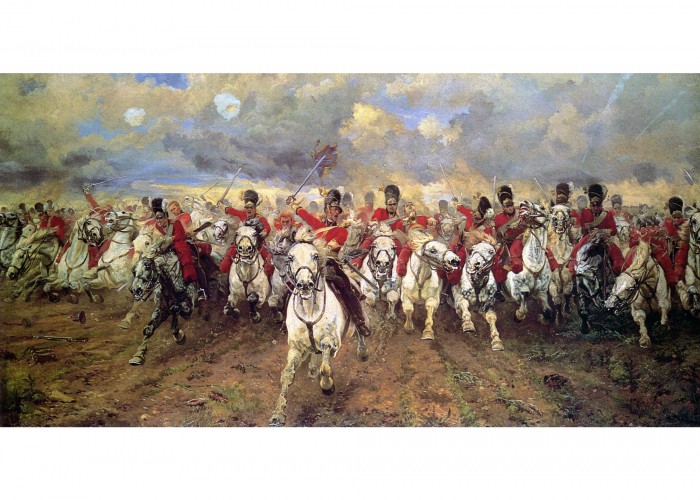Scotland For Ever!, Lady Elizabeth Butler
This wonderful painting depicts the 2nd (Royal North British) Regiment of Dragoons, a British cavalry regiment later known as the ‘Scots Greys’, at full charge during the Battle of Waterloo. It was not only painted by a woman, which was rare enough among battlefield artists of the 19th century, but by a woman who had never witnessed a battle.
Elizabeth, Lady Butler (1846-1933) was only able to capture the image of the charge because her husband’s regiment, the 69th, allowed her to watch manoeuvres. She also stood in front of charging cavalry to capture the momentum of the horses. By using a brilliant white pigment to enhance the grey coats she created a truly awesome sight. No wonder Napoleon is said to have called them “those terrible men on grey horses”.
In the Battle of Waterloo the Scots Greys were truly heroic but suffered great losses as they came to the rescue of the allied infantry. When General d’Erlon’s I Corps threatened to overwhelm the left of the allied line the British heavy cavalry was called into action.
The Scots Greys were brigaded under common command of General William Ponsonby with the 1st (Royal) Regiment of Dragoons and the 6th (Inniskilling) Regiment of Dragoons, the Scottish, English and Irish regiments forming the Union Brigade. The three regiments advanced for the charge and although the Greys were supposed to be the reserve unit (upon which the other two units could rally) the 391 men quickly broke through the French infantry, taking an eagle in the process. Unfortunately, they kept going even after the French had been routed. They overran the guns but then found themselves confronted by French cavalry. Their horses were exhausted, with the result that they lost 102 men killed and 98 wounded.
The artist, Lady Butler, was born Elizabeth Sutherden Thompson. She was already known as an artist of military subjects when she married Major (later Lieutenant General Sir) William Butler of the 69th in 1877. Several of her previous paintings were so well received that queues formed outside The Royal Academy, while Queen Victoria bought the ‘The Roll Call’. ‘Scotland for Ever’ was a huge success and became an iconic representation of heroism, being reproduced many times. Tzar Nicholas II and Kaiser Wilhelm II were both given copies and later during the Great War (1914-1918) both the British and the Germans used the image for propaganda, with the Scots Greys transformed into Prussian cavalry by the Germans.
This picture is of a photolithograph from 1887, a 19th century method of reproducing images in colour. The original painting can be seen in Leeds Art Gallery.
-
Curatorial info
- Accession Number: NAM. 1982-07-39
- Production Date: 1887
- Technique: Photolithograph
-
Use this image
You can download and use the high resolution image for use in a non-profit environment such as a school or college, but please take note of the license type and rights holder information below
- Rights Holder: None.
- License Type:
Public domain
Find it here
This object is in the collection of National Army Museum







